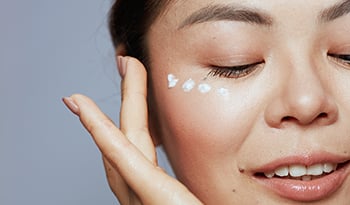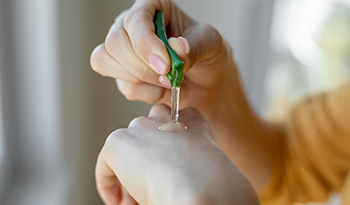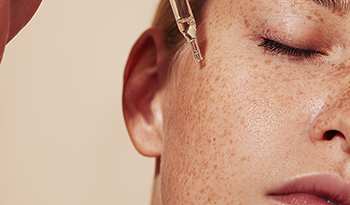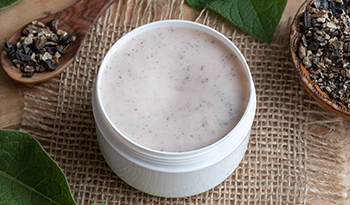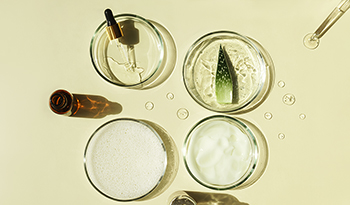Centella Asiatica : Un ingrédient de soin qui fait le buzz

La Centella asiatica fait parler d'elle en ce moment, et si vous avez été attentif, vous avez peut-être remarqué que cette plante fait son apparition dans un certain nombre de nouveaux produits de soins de la peau. ;
Qu'est-ce que la Centella Asiatica ?
La Centella asiatica, également connue sous le nom de gotu kola, pennywort, Brahmi et herbe du tigre, est une plante utilisée depuis des années par voie orale et topique dans le cadre de la phytothérapie traditionnelle, ainsi qu'à des fins culinaires. La plante pousse dans les régions tempérées et humides de l'Asie du Sud-Est, de l'Afrique du Sud, de Madagascar et même de certaines parties du Sud-Est des États-Unis, entre autres. Légume vert feuillu riche en caroténoïdes, en vitamines C et B et en autres nutriments bénéfiques pour la santé, il est consommé dans les bouillies, les salades et les boissons de bien-être dans de nombreux pays, dont le Sri Lanka, la Malaisie, l'Indonésie, la Thaïlande et l'Inde.
Pourquoi la Centella Asiatica est-elle populaire ?
La Centella asiatica aurait des effets anti-inflammatoires, antioxydants et antimicrobiens sur toute une série de problèmes de santé, ce qui explique l'intérêt qu'elle suscite dans les pratiques occidentales.
Dans le monde des soins de la peau en particulier, Centella asiatica apparaît fréquemment dans les crèmes hydratantes appelées "cica creams". Le terme "cica" est dérivé du mot latin "cicatrix", qui signifie cicatrice, et est ainsi nommé parce que de nombreuses études sur la Centella asiatica se sont concentrées sur son rôle dans la cicatrisation des plaies et la formation de cicatrices. La centella asiatica est en fait utilisée dans les produits de soins de la peau depuis de nombreuses années, mais elle est passée inaperçue jusqu'à ce qu'elle soit récemment popularisée dans les produits de soins de la peau coréens (K-beauty).
Les principaux "ingrédients" actifs de la Centella asiatica sont des triterpènes tels que l'asiaticoside, le madécasosside, l'acide asiatique et l'acide madécassique. Ces noms sont utiles à connaître car ils peuvent figurer dans la liste des ingrédients d'un produit. Il existe également plusieurs extraits exclusifs de Centella asiatica, tels que Madecassolã, Blastoemullinaã et Centellaseã.
Quels sont les effets sur la peau ?
Propriétés antioxydantes et antimicrobiennes
Vous vous demandez ce qui fait de la Centella asiatica une plante aussi remarquable ? La centella asiatica aurait un certain nombre de bienfaits possibles pour la peau, notamment une activité antioxydante et antimicrobienne, des propriétés anti-inflammatoires, une amélioration de la cicatrisation, une amélioration de la formation des cicatrices et même une hydratation supérieure et une fonction de barrière cutanée. ;
Apaise et hydrate
La plupart des produits de soins de la peau intègrent la Centella asiatica dans leurs crèmes de soin afin d'apaiser et d'hydrater la peau. Bien que les capacités d'hydratation des crèmes à base de cica fassent l'objet d'un battage médiatique anecdotique, la littérature scientifique ne fournit que peu de données à ce sujet. Dans une étude non randomisée et non aveugle menée auprès de 25 personnes, des préparations de crèmesCentella asiatica en crèmes et en hydrogels de différentes concentrations ont été appliquées sur l'intérieur des avant-bras et comparées à des témoins (c'est-à-dire des crèmes/hydrogels ne contenant pas de Centella asiatica) qui ont été appliqués sur l'extérieur des avant-bras pendant quatre semaines. ;
L'étude a révélé que les zones traitées avec ;Centella asiatica présentaient une amélioration statistiquement significative des rougeurs cutanées, de la perte d'eau transépidermique (c'est-à-dire de la capacité à maintenir l'hydratation) et de la diminution du stress oxydatif (c'est-à-dire des dommages causés par l'inflammation).
Il est encourageant de constater que ces résultats s'accentuent avec l'augmentation des concentrations de Centella asiatica, mais la peau des avant-bras extérieurs peut avoir des caractéristiques intrinsèquement différentes de celles de la peau des avant-bras intérieurs, de sorte que les comparaisons entre les deux ne sont peut-être pas infaillibles. Une autre étude, qui était une évaluation randomisée en aveugle de 20 femmes, a démontré que l'hydratation de la peau et la fonction de barrière étaient améliorées après l'utilisation de Centella asiatica. Cependant, il a été appliqué dans un liquide contenant également de l'acide hyaluronique et de la glycérine, qui sont des hydratants bien connus, de sorte qu'il est difficile de savoir dans quelle mesure les avantages observés provenaient de la Centella asiatica par rapport aux autres ingrédients.
Augmente la production de collagène
Une autre découverte intrigante est que de nombreuses études ont démontré des capacités d'augmentation de la production de collagène, de renforcement des cicatrices et d'amélioration de la cicatrisation grâce à l'utilisation de Centella asiatica. La majorité d'entre elles ont eu lieu en laboratoire et sur des modèles animaux, mais il en existe plusieurs chez l'homme et même quelques essais cliniques. Par exemple, une étude clinique russe a étudié le Madecassolã chez des patients atteints de sclérodermie, qui est un trouble du collagène/de la cicatrisation, et une autre a été menée chez des patients diabétiques dans un hôpital en Thaïlande, qui a montré une amélioration de la contraction de la plaie (c'est-à-dire que la plaie guérit plus rapidement). Des études chez l'homme ont également montré une amélioration de la pigmentation des cicatrices ainsi qu'une prévention des chéloïdes et des cicatrices hypertrophiques. En se basant sur les effets observés sur le collagène et la cicatrisation, on peut voir comment Centella asiatica pourrait également avoir des avantages pour minimiser l'apparence des rides et du vieillissement, qui sont causés par une perte de collagène au fil du temps. ;
Considérations particulières pour Centella Asiatica
Comme pour tous les produits à base de plantes, il existe un risque de réactions cutanées si le produit n'est pas formulé de manière appropriée (c'est-à-dire en n'éliminant pas les parties de certaines plantes qui peuvent provoquer des irritations et des réactions allergiques). Au cabinet de dermatologie, il n'est pas rare de voir des personnes arriver avec une peau rouge, enflammée et qui démange (dermatite de contact) causée par les composants végétaux des produits naturels. Il est donc important de rechercher des produits qui ont été testés sur les peaux sensibles et de prêter attention à la façon dont votre peau réagit aux nouveaux produits. De nombreuses marques de soins de la peau de confiance en sont conscientes et s'efforcent de formuler leurs produits de manière à ce qu'ils soient moins susceptibles de causer des problèmes. Cependant, il y a toujours un risque que cela se produise, donc pour les personnes sujettes à des réactions cutanées, il est parfois judicieux de faire son propre "test épicutané". Avant de l'appliquer sur une plus grande surface, appliquez le produit sur une zone de l'avant-bras pendant quelques semaines pour vous assurer que vous n'avez pas de réaction. ;
À ce propos, du point de vue d'un dermatologue, il convient de mentionner que deux des formulations exclusives de Centella asiatica (Madecassolã et Blastoemulinaã) sont composées d'une combinaison de ;Centella asiatica et de néomycine. La néomycine est un antibiotique topique très répandu dans de nombreuses crèmes pour plaies en vente libre, mais les dermatologues n'en sont pas de fervents adeptes car elle provoque fréquemment des réactions cutanées allergiques. La bonne nouvelle est que ni l'une ni l'autre de ces formulations n'est utilisée dans la plupart des crèmes à base de cica commercialisées ou dans les produits que j'ai mis en évidence ci-dessous, mais il est bon d'en être conscient au cas où vous les trouveriez ailleurs.
Une autre chose importante à souligner à propos de la Centella asiatica est qu'elle appartient à la famille botanique des Apiacées, qui comprend de nombreuses plantes comestibles merveilleuses que vous reconnaissez, telles que le céleri, la figue, le fenouil, le panais, le persil et l'aneth. Bien que délicieuse, cette famille de plantes constitue l'une des causes les plus fréquentes d'une réaction cutanée appelée "phytophotodermatite", ce qui est une façon élégante de dire "inflammation de la peau liée aux plantes et au soleil". En fait, si la substance végétale est appliquée sur votre peau et que vous vous exposez au soleil, elle peut provoquer des cloques et des rougeurs qui finissent par s'estomper pour laisser place à une décoloration brune. Heureusement, la plupart des produits de soins de la peau utilisent des extraits distillés de la plante, de sorte que cela ne se produit pas, et cela ne semble pas être un problème signalé jusqu'à présent avec les ;crèmes à base de cica. D'autre part, certaines sources montrent même que la Centella asiatica peut combattre les rougeurs et les irritations causées par le soleil et d'autres inflammations.
En résumé, cette plante à la mode fait des vagues dans le monde des soins de la peau en raison des avantages qu'elle présente : lutte contre l'inflammation, amélioration de l'hydratation, renforcement de la barrière cutanée, amélioration de la cicatrisation et de la formation des cicatrices.
CLAUSE DE NON-RESPONSABILITÉ:Ce CENTRE DU BIEN-ÊTRE n'a pas pour but de fournir un diagnostic...













































































 Table des matières
Table des matières




